I'm struggling with UITableView. As you can see in this video in third section of table view third cell isn't display correctly. That happens when I dequeue my cell like that:
let cell = tableView.dequeueReusableCell(withIdentifier: MultipleSelectAnswerSurveyTableViewCellIdentifier, for: indexPath) as! MultipleSelectAnswerSurveyTableViewCell
cell.setup(answer: question.answers?[indexPath.row].value ?? "", isSelected: false, style: style, isLastInSection: indexPath.row == (question.answers?.count ?? 1) - 1)
return cell
Cell's setup() method:
func setup(answer: String, isSelected: Bool, style: Style, isLastInSection: Bool) {
self.isLastInSection = isLastInSection
selectionStyle = .none
backgroundColor = style.survey.singleSelectAnswerTableViewCell.backgroundColor
answerLabel.textColor = style.survey.singleSelectAnswerTableViewCell.answerLabelColor
answerLabel.font = style.survey.singleSelectAnswerTableViewCell.answerLabelFont
answerLabel.text = answer
addSubview(answerLabel)
addSubview(selectionIndicator)
answerLabel.snp.makeConstraints { make in
make.left.equalTo(8)
make.centerY.equalTo(selectionIndicator.snp.centerY)
make.top.equalTo(8)
make.bottom.equalTo(-8)
make.right.equalTo(selectionIndicator.snp.left).offset(-8)
}
selectionIndicator.snp.makeConstraints { make in
make.right.equalTo(-8)
make.top.greaterThanOrEqualTo(8)
make.bottom.lessThanOrEqualTo(-8)
make.width.height.equalTo(26)
}
}
self.isLastInSection variable is used inside layoutSubviews():
override func layoutSubviews() {
super.layoutSubviews()
if isLastInSection {
roundCorners(corners: [.bottomLeft, .bottomRight], radius: 16.0)
}
contentView.layoutIfNeeded()
}
And finally roundCorners():
extension UIView {
func roundCorners(corners: UIRectCorner, radius: CGFloat) {
let path = UIBezierPath(roundedRect: bounds, byRoundingCorners: corners, cornerRadii: CGSize(width: radius, height: radius))
let mask = CAShapeLayer()
mask.path = path.cgPath
layer.mask = mask
}
}
When I dequeue cell with isLastInSection set to false cell is being displayed as expected (related video). So I think the problem is in life cycle of the cell and when the layoutSubview() is being called. I tried many solutions for similar problem found in different threads but none of them helped me. tableView(_:heightForRowAt:) causes the third cell to display correctly, but the first one has rounded bottom corners. Also all of them are fixed in height and that cannot happen.
But what is really weird: when I print the isLastInSection during dequeueing cell which is unexpectedly rounded debugger returns me false:
(lldb) po indexPath.row == (question.answers?.count ?? 1) - 1
false
As you can see in Debug View Hierarchy view text exists so that's why I 've defined the problem as hiding part of content.

